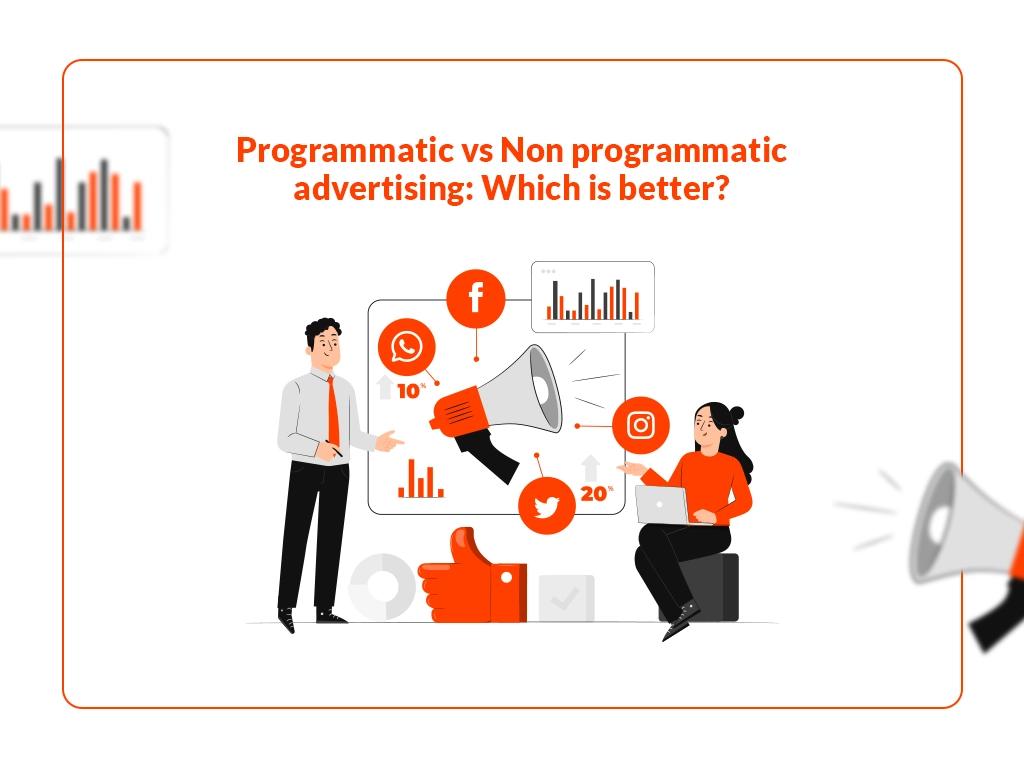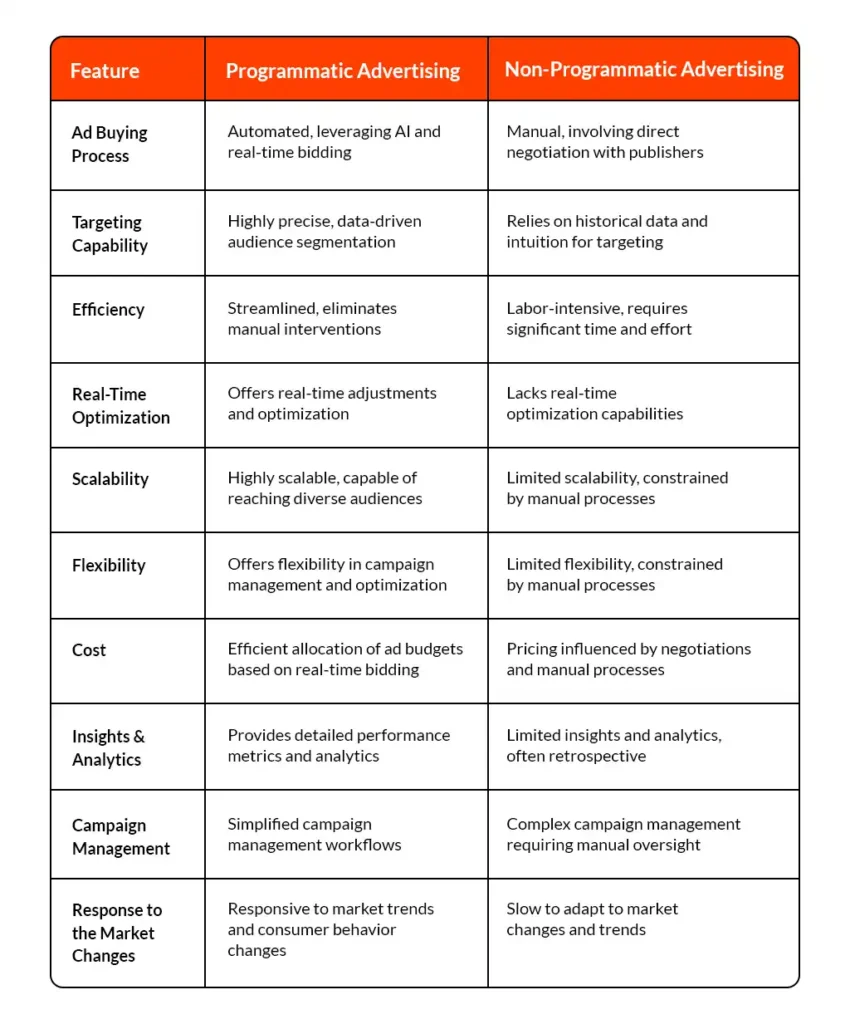Programmatic vs Non programmatic advertising: Which is better?

Introduction:
In today’s fast-paced advertising landscape, the emergence of programmatic advertising has heralded a new era of marketing innovation. With its ability to automate and optimize ad buying processes, programmatic advertising has swiftly become a cornerstone of digital marketing strategies worldwide. Yet, despite its widespread adoption and undeniable impact, the nuances distinguishing programmatic from non-programmatic advertising often elude many marketers and advertisers.
At its core, programmatic advertising represents a paradigm shift in how brands engage with their target audiences. By leveraging sophisticated technologies like automation, artificial intelligence, and real-time bidding, programmatic ads transcend the limitations of traditional advertising methods. Instead of relying on manual interventions and human judgment, programmatic platforms harness data-driven insights to precisely target audiences and deliver tailored messages at scale. This data-centric approach not only enhances ad relevance and effectiveness but also empowers advertisers to optimize campaign performance in real time.
However, amidst the buzz surrounding programmatic advertising, the distinction between programmatic and non-programmatic approaches remains shrouded in ambiguity for many industry professionals. Non-programmatic advertising, often referred to as traditional or direct advertising, adheres to manual processes for ad buying and placement. In this model, advertisers must personally negotiate ad placements with publishers, allocate budgets, and oversee campaign management activities. While non-programmatic methods offer a degree of control and customization, they are often labor-intensive and lack the agility and efficiency of programmatic platforms.
In this comprehensive exploration, our aim is to demystify the complexities of both programmatic and non-programmatic advertising, offering insights into their unique characteristics, benefits, and limitations. By shedding light on the fundamental differences between these two approaches, we seek to empower marketers and advertisers with the knowledge and understanding needed to make informed decisions and navigate the ever-evolving landscape of digital advertising effectively. Whether you’re a seasoned marketing professional or a newcomer to the field, join us on this journey as we unravel the intricacies of programmatic vs non-programmatic advertising and unlock the keys to advertising success in the digital age.
What is Programmatic Advertising?
Programmatic advertising represents a seismic shift in the way advertisers conceptualize and execute their marketing strategies. By leveraging cutting-edge technologies like automation, artificial intelligence (AI), and real-time bidding (RTB), programmatic ads have transcended the confines of traditional advertising methods, ushering in a new era of efficiency and effectiveness in the advertising ecosystem.
At its core, programmatic advertising operates on a data-driven foundation, harnessing insights gleaned from vast troves of consumer data to inform strategic decision-making. Unlike traditional ad buying methods, which often rely on guesswork and intuition, programmatic platforms enable advertisers to pinpoint their target audiences with unparalleled precision. Through advanced audience segmentation and targeting capabilities, advertisers can tailor their messaging to resonate with specific demographics, interests, and behaviors, maximizing the relevance and impact of their ad campaigns.
Furthermore, the automation inherent in programmatic advertising streamlines the ad buying process, eliminating the need for manual interventions, and streamlining campaign management workflows. With programmatic platforms handling tasks such as ad placement, bidding, and optimization in real time, advertisers can allocate their resources more efficiently and focus on strategic initiatives rather than administrative tasks.
Real-time bidding (RTB) further enhances the efficiency and effectiveness of programmatic advertising by enabling advertisers to compete for ad inventory in live auctions. This dynamic bidding process ensures that ad placements are allocated to the highest bidder in real time, maximizing the value of each impression and optimizing campaign performance.
Moreover, the versatility of programmatic advertising allows advertisers to reach audiences across a diverse array of digital channels, including display, video, mobile, and social media. This multi-channel approach ensures maximum visibility and engagement, enabling advertisers to connect with consumers wherever they may be online.
Programmatic advertising represents a quantum leap forward in the evolution of ad buying and selling. By harnessing the power of automation, AI, and data-driven insights, programmatic ads empower advertisers to optimize ad placement, maximize audience reach, and drive superior campaign results in today’s fast-paced digital landscape.
What is Non-Programmatic Advertising?
Non-programmatic advertising stands in stark contrast to the automated processes characteristic of programmatic advertising. Instead of relying on sophisticated technologies like automation and real-time bidding, non-programmatic advertising adheres to traditional manual processes for ad buying and placement.
In non-programmatic advertising, advertisers must navigate a series of manual tasks, including identifying target audiences, allocating ad budgets, and negotiating directly with publishers for ad space. Unlike programmatic platforms, which leverage data-driven insights to precisely target specific audiences, non-programmatic approaches often rely on intuition and historical data for audience targeting.
While non-programmatic methods offer advertisers a greater degree of control and customization over their ad campaigns, they come with inherent limitations. The manual nature of non-programmatic advertising makes it labor-intensive and time-consuming, requiring advertisers to invest significant resources in campaign planning and execution.
Additionally, non-programmatic approaches lack the real-time optimization capabilities of programmatic platforms, making it difficult for advertisers to adjust their strategies in response to changing market conditions or consumer behavior.
Overall, non-programmatic advertising represents a more traditional approach to ad buying and placement, characterized by manual processes and limited scalability. While it may offer certain advantages in terms of control and customization, it falls short of the efficiency and effectiveness offered by programmatic advertising in today’s fast-paced digital landscape.




